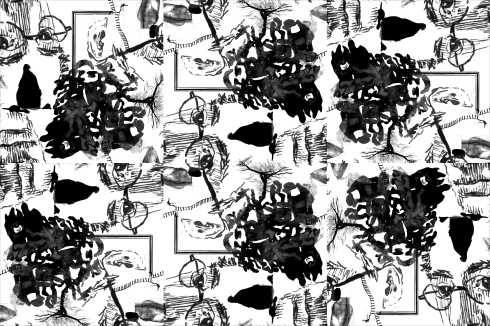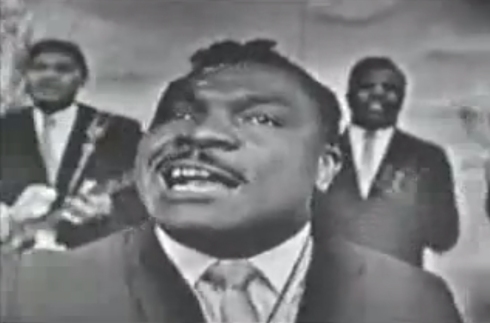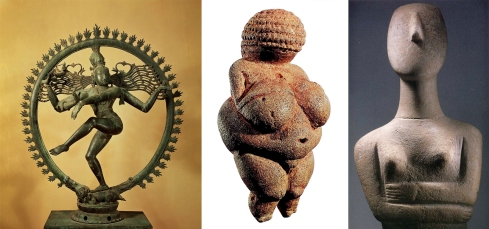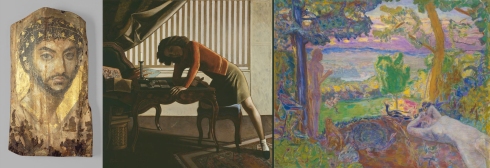You are currently browsing the category archive for the ‘Uncategorized’ category.
Referencing some of the background information you’ve learned about one of these artists (or from further research you do), reflect on how the artist represents or expresses her identity in one of these specific works: Lick and Lather by Janine Antoni 1993, a recent self portrait by Chuck Close (see him on the Colbert Report here), Kalkidan (from the World Stage: Israel) 2011 an oil painting by Kehinde Wiley, Shahzia Sikander’s Hood’s Red Rider 1997, Mother and Child by William Wegman, and Chicago native Kerry James Marshall’s Untitled (Painter) 2010. As usual, clicking on the images will make them larger.
Consider the artist’s identity as it is influenced by and a reflection of her race, gender, sense of place, religion, individual and cultural background. Does the artist reveal or conceal identity? Does the work speak more about the artist’s identity or invite its audience to engage their own? Other reflections? Consider the work’s form, media and installation.
Artists dissatisfied with the injustices around them often express their desire for change by representing their ideals through the worlds they create. Consider two (2) of the following works in light of the cultural milieu in which they were created. Ground your response with details about the individual artists that you have learned from class, the reading and/or other research, and be specific in your description of the works’ shared formal qualities (what it looks like) and/or construction (how it was made) by using some of the following terms/ideas in your post: cubist, pointillist, primitive, contour, planar, surface, and cropping. The works are: a detail of a still from Fritz Lang’s 1927 film Metropolis; For the Love of God, by Damien Hirst, 2007 (hear the artist speak about the work here); Dynamism of a Dog on a Leash, by the Italian futurist Giacomo Balla, 1912; a still of Pablo Picasso drawing from the film Visit to Picasso, 1949; Dress by the Russian futurist Natalia Goncharova, 1924; and Blue Nude, a papercut work by Henri Matisse (and a documentary photo of the artist at work in this media), 1952 (watch this trailer to a very interesting documentary, and the whole thing on Netflix if you have time). As usual, click on the links for a lively jaunt, and on the images to see them larger.
Your five small gradient drawings have been stitched together digitally to recreate this image, Flight Into Egypt, 1452 by Fra Angelico, one of the great but humble painters of the early Italian Renaissance. Click here to read Vasari’s near contemporary account of his life and work. To see or download a larger image created from your gradient drawings, click on the detail above or on the full image below. Or to download a full-size pdf file to peruse and/or print on your own laser or inkjet printer (on 35 letter size pages) and assemble over the break, click here!
Here are some more detailed instructions for your final “studio” project:
1) Think of some significant moments in your personal or family history. Choose one that has a particular and memorable location. In 25-100 words write this story. The more poetic and succinct the better. Separate one short line from the whole. This might be a quote, or climax, or denouement… something that sums up the memory or perhaps expands it to your present context, etc…. Please add your story as a comment to this post.
2) Next, think of a path you have memorized having traveled it repeatedly. It should be a route that is not simply a straight line, and that returns to its starting point (to make a loop). Make a drawing of this path from memory as a map, as accurately as possible. If possible, look at a satellite or internet map source of this same path to see how you did. It does not necessarily have to connect to your story.
3) Gather visual references (or create your own!) that connect with your narrative. Organize all three of these elements (text of your story, looped graphic of your path, and these gathered or created visuals) into a compositional structure that flows naturally from the story. Let complexity build slowly and meaningfully.
Incorporate several visual ways (design principles) of bringing order and richness to your piece: line, rhythm, balance, scale, texture, value, color (ie. limited palette), pattern, framing, layers, transparency, grid, diagram, contrast, emphasis…. For inspiration from those who have gone before, click here. Final size of the page should be 8×10 inches (note: that is smaller than letter size). Convince me/us that you have considered every square inch of the composition. This does not necessarily mean you have to “fill” the entire space, but that you have thought about and taken care with the whole. Enjoy yourself in the making! Your pieces are due on our last scheduled class, when we will share and celebrate them.
Here is a link to the pdf of images organized around the foundational design principles that we looked at in class (warning: very big file). Please refer to it as you begin to think about ordering/composing your piece.
To make your repeating pattern, choose one of the following options:
I. Create a horizontally repeating module. Create your design (drawn, painted, collaged, etc…) in the middle of a block of four squares (A). It need not be figurative or representational. It can be abstract, and in either black and white or color. Cut the four blocks apart, and tape them back together on the back, moving each block to the opposite corner (B). Next, fill the now open center area of the newly constructed block of four squares with elements and designs of your choice (C). If any of these elements cross over the edge, the “missing” part must reappear on the opposite edge, as in the hemispheres of the sun (D). Make six photocopies of your module, cut them out and attach them to one another in a 2×6 grid (below). If you need another handout, you can print one from here.
II. Create a rotating module. Make marks along the edge of one of the sides of your square. Measure the distances of these marks and transfer them to each of the remaining sides of the square (below A). Create your design by connecting these marks in some way. It can be linear as in below (B), or combined with value (C).
Make six photocopies of your module, cut them out and attach them to one another in a 2×6 grid, rotating them either in a random way (below) or with a patterned rotation. The points along the edges should match up at least in some instances.
III. Or some combination of the two options. In the examples below, the design was created initially as one that would work in horizontal rows, but rotating them began to yield interesting patterns and alignments as well. Note how the “frame corner” begins to move throughout the overall patterned field and begins to throw your eye “off” (that is, you see these corners as the edges of a new tile)
In your design, everything need not perfectly line up. In fact, it is sometimes these “slips” or accidents that make for the most compelling designs. Have fun, and bring your completed designs to class on Thursday morning!
Throughout history pilgrims have left their homes and wandered great distances to find spiritual enlightenment. Discuss two of the works of art depicted in this post as they relate to the idea of pilgrimage. Consider the work in its original or initial context—how the first pilgrims would have engaged the pieces/sites—and also contemporary appreciation, devotion, tourism, etc…. Give a specific historical reference from your text or other research to situate and support your thoughts. The works are: Reliquary of St Eustace (containing part of his skull), Basel Switzerland, ca 1210AD; Gold Leafed Glass fragment (with Saints Peter, Paul and Peregrin), Roman, ca 350AD, Mosaic Mihrab (prayer niche) from the Great Mosque, Isfahan Iran, ca 1310AD; Holy Women at the Tomb, depicting Christ’s empty tomb, carved ivory, early 5th century, Crystal Cathedral bell tower, designed by Philip Johnson, Garden Grove CA, 1990, and Holy Water Pilgrimage Flask (with St Sergios Blessing), Syrian Byzantine, 6th-7th Century. Click the pictures to see them larger.
Please remember to engage with / fill in the boxes on the paper I gave you yesterday, dealing with the idea of pilgrimage. And again, remember that the most important thing is that you try to create a stepped gradient from box to box (so that the first box is roughly 10% gray, the second 30%, third 50%, fourth 70% and the last 90%), matching the gray strips below the boxes. Hold your paper up to these and squint to see how they match up. The tendency will be to not go dark enough. Use whatever media you like: pencil, pen, marker, collage, paint, mud, etc…. If you accidentally lose your sheet, there are more on the whiteboard ledge in the class room, or you can print one from this pdf. (examples above are by former students Susan Jones, Amber Stenberg, and Edward Meadors)
And for some soul stirring, click on the picture of Paul Foster above to hear his rendition of I Am a Pilgrim. Highly recommended.
Compare and contrast two of the representations of gods in this post (Shiva Lord of the Dancers, cast bronze, ca 1100AD, southern India; the Venus of Willendorf, limestone, ca 23,000BC (watch The Sculpture Diaries lively romp about this piece; a Cycladic figurine, ca 2500BC; Smiling Buddha, Angkor Wat, Cambodia, early 12th C; Claus Sluter’s Head of Christ, late 14th century Dutch, from the Well of Moses, and the 6th century San Sisto Madonna (Madonna of the Golden Hands). Be specific, descriptive and poetic as you consider the formal (material, what and how it’s made) and compositional qualities of the pieces in relation to the culture and religion in which they were produced (ie. the texture of Venus’ hair was likened to cornrows in a previous semester). Use some of these terms in your response: free-standing, relief, additive, subtractive, abstract, and naturalistic. Click on the images to view them in greater detail.
I will be going into the city on Tuesday, the 2nd of October (as originally proposed on the syllabus). You are not required to go on this day, but you must find your way at some point to a museum, gallery, or public artwork, to write your short paper. Depending on the interest, we can go to either the Museum of Contemporary Art (which is free on Tuesdays) or the Art Institute (which is free all the time for you as Wheaton students). Because of timing, we won’t have class at 8:30. Instead, I will plan to meet anyone interested in going at the College Ave station to catch the 9:57am train, which will get into Chicago at 10:50am. We can take the 3:40pm train back to arrive at college ave at 4:30pm, but if you need to get back before then, you can always catch the 2:40 (getting back at 3:30) if you need, or stay later if you want to enjoy dinner in the city. Train tickets are $4.50 each way, and I would bring some money for lunch or a packed one from bon appetit. We’ll walk from the station to one of the museums, so wear comfortable shoes.
Paper Instructions: Your task for the final paper is to spend significant time, around thirty (30) minutes, in person with a single work of art. It will seem difficult at first, but try to slow down your pace, and look deeply and intently at the piece.
1. Take notes. Make sketches. Be as specific and descriptive as possible of what you see. Use plentiful adjectives and active verbs to enrich your writing. Consider the formal elements and principles of design (don’t just list them, but engage those that are most evident): If there is line what is its quality (eg. sinuous and delicate or rough, jagged). Is form created through the depiction of shapes and planes or by build up of texture and mass? Are brushstrokes or the bites of a chisel evident, or have surfaces been smoothed out? Does negative space flow in and around the volumes, or is it trapped, dense and solid? What hues have been chosen, and what is their specific quality (value, intensity, or saturation)? How have the elements been composed or arranged in relation to one another, the location, and the audience, and in what manner or style has the subject been visually executed? How does this contribute to the feel or possible meaning(s) of the work?
When you think you have seen everything there is to see, put your pencil down and close your eyes. When you open them, look at the piece again. Look at the title if you haven’t already, and any additional information which might help to give some further context for the piece.
2. Next, interpret the work in light of at least one of the major themes we have been studying in our text: the Earth as Art, Representations of the Divine, Pilgrimage, the shifting role of the artist in relation to her patrons, the idea of Utopia and Dystopia, and the Spirit World and the Inner Mind. Refer back to a specific work we looked at either in the text, in class, or online in the blog.
3. And finally, end with some concluding thoughts. The entire paper should be between 500-750 words and fit on a single page (make your type smaller or single spaced). Better to be short and interesting than rambling and incoherent. On a cover page, include a color image of the work and your name. Due in my box (2nd floor of Adams) by 4:30pm on Thursday, October 11th, but you may bring it earlier to me if you like.
* For those of you who are unable to make it to the field trip or to one of the Chicago museums on your own, you may choose a work that is at another local gallery or museum, like one of the wonderful shows at the Chicago Cultural Center. You might also consider an outdoor piece of sculpture and its context (another FREE alternative), as Chicago is a wonderful city for public sculpture. Also, Benedictine University in nearby Lisle has a wonderful collection of contemporary religious works throughout its campus, and in the architecturally significant abbey: St Procopius. (The above image is: Prevalence of Ritual by Romare Bearden, 1974; and below are works from the Art Institute: portrait from Fayum, Egypt and paintings by Balthus and Pierre Bonnard, and below: a handcolored woodcut print from one of the current shows).
Choose two of the six works in this post to compare and contrast (Christo and Jeanne-Claude’s Running Fence 1976, the ancient Nazca Line Monkey in Peru, Surrounded Islands by Christo and Jeanne-Claude 1983 (click here to see Christo talk about his work), Richard Long’s Walking a Line in Peru 1972 (click here for a recent video review), Giuseppe Penone’s Tree Door 1993 (where he carefully carves away to reveal the sapling within), and Nancy Holt’s Sun Tunnels 1973-76). Click on some of the links to find out more. Then think about the process used to create them (number of people required, time and energy taken, location, materials, etc…) and how this process relates to your understanding and interpretation of the works’ meaning(s). Consider at least two of the following concepts in your response: orientation, structure, sublime, minimalism, contrast, temporal vs permanent and collaboration. Click on the images to view them in greater detail.
And a few more video links for your enjoyment:
Ned Kahn: an artist who works with visualizing wind on the surface of buildings. Click this one for sure!
Patrick Marold: sculptor / friend who worked with Andy Goldsworthy for a few years.

























